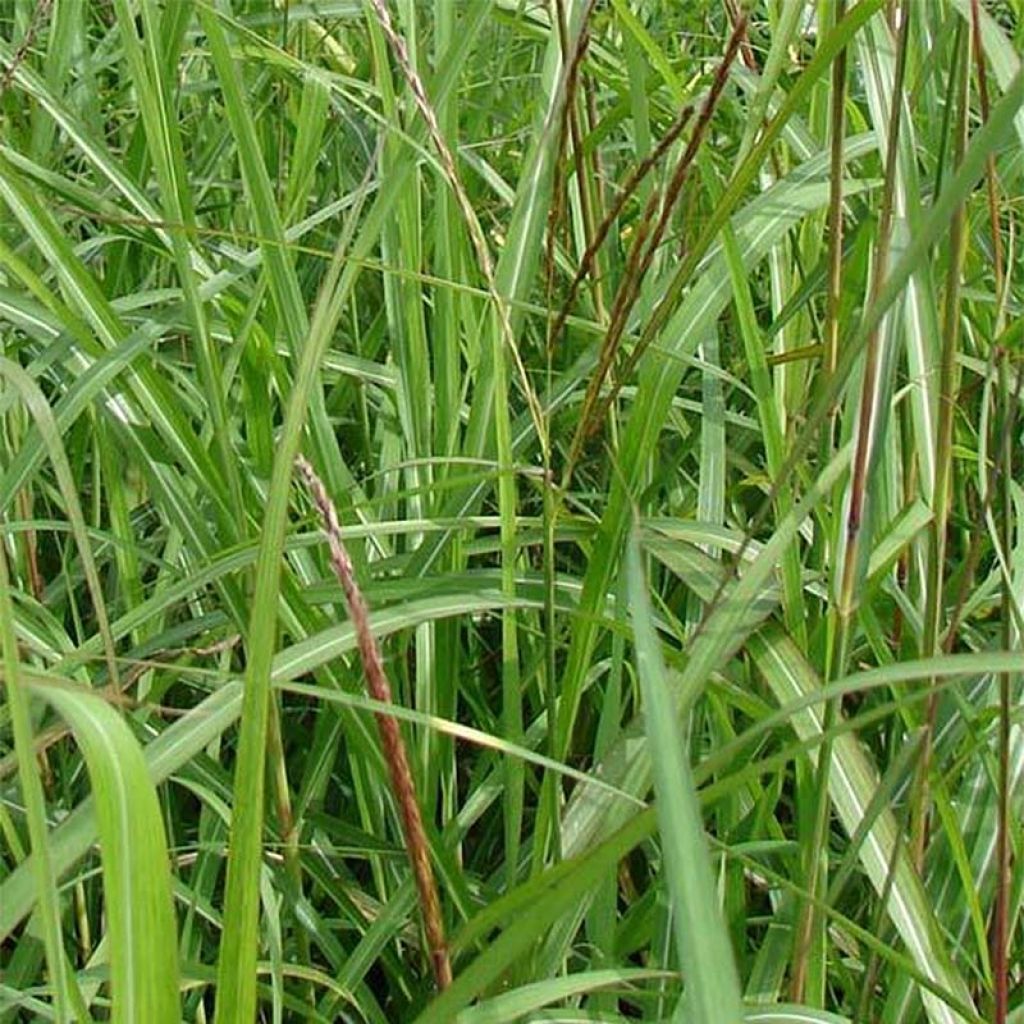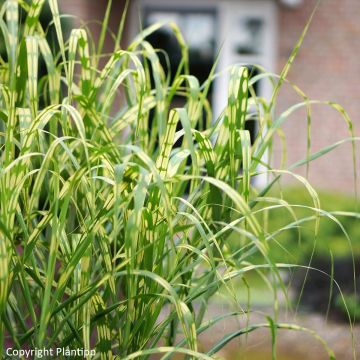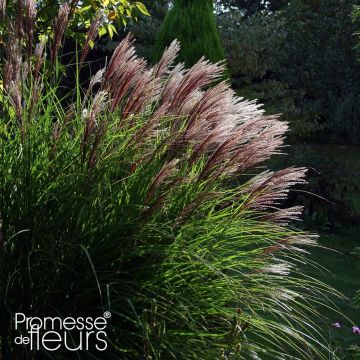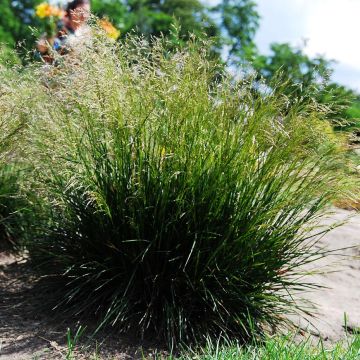

Miscanthus sinensis August Feder - Eulalie, Roseau de Chine
Miscanthus sinensis August Feder - Silvergrass
Miscanthus sinensis August Feder
Eulalia, Porcupine Grass, Chinese silver Grass, Maiden Grass, Zebra Grass, Susuki Grass
Why not try an alternative variety in stock?
View all →This plant carries a 12 months recovery warranty
More information
We guarantee the quality of our plants for a full growing cycle, and will replace at our expense any plant that fails to recover under normal climatic and planting conditions.
From €5.90 for pickup delivery and €6.90 for home delivery
Express home delivery from €8.90.
From €5.90 for pickup delivery and €6.90 for home delivery
Express home delivery from €8.90.
Does this plant fit my garden?
Set up your Plantfit profile →
Description
Miscanthus sinensis 'August Feder' is a variety of maiden grass or Chinese silver grass with an early flowering of large white-silver feathery spikes, and a beautiful stature. This ornamental grass blooms from August, even in cool climates, and its inflorescences that rise to human height remain decorative for a long time, adopting light pale brown-pinkish tones throughout autumn. Its significant development makes it perfect as a windbreak or privacy screen, even if the wind sometimes knocks it down. This beautiful perennial adapts to any ordinary, well-drained, and deep soil, and can even tolerate moderate drought.
'August Feder' belongs to the Poaceae family. It is a horticultural selection derived from Miscanthus sinensis, native to East Asia and Oceania. This grass with short rhizomes develops into a non-spreading and non-invasive clump. It is described as tufted. With an upright and trailing habit, the plant reaches 1.8m (6ft) in height when flowering, with a minimum spread of 80cm (32in). The leaves are wide and ribbon-like, very long and flexible, with a distinctly dark green colour marked by a light and silvery stripe along the main vein. The flowering is particularly early and generous, and can be noticed from afar. Long flower stems emerge from the foliage from August to October, in the form of very fine and finger-like erect silky spikes, 20 to 25 cm (8 to 10in) long, tinged with white. As they fade, they take on a more silvery hue, nuanced with very pale beige-pink to blonde. The plumes remain on the dry plant for a good part of winter, retaining an appreciable decorative aspect during the "dull" season. The deciduous foliage dries out in winter.
Designed for large plantings, these tall grasses bring a beautiful structure and grace to a planting scheme. However, they need enough space to express themselves. Plant them among asters or behind perpetual roses, and let them grow and expand. In a wild and tousled or modern and minimalist atmosphere, watch them play with the wind and the low autumn light, and bend under rain showers. Miscanthus are well suited for hedge planting, constituting a screen along a path, to isolate a part of the garden, as a privacy screen or windbreak. These grasses provide volume and create a natural transition between spaces. In the city, Miscanthus 'August Feder' blends well with its discreet colours. It is magnificent planted near water features, alongside vernonias in well-drained soil.
Report an error about the product description
Miscanthus sinensis August Feder - Silvergrass in pictures


Flowering
Foliage
Plant habit
Botanical data
Miscanthus
sinensis
August Feder
Poaceae
Eulalia, Porcupine Grass, Chinese silver Grass, Maiden Grass, Zebra Grass, Susuki Grass
Cultivar or hybrid
Other Miscanthus
Planting and care
Miscanthus sinensis 'August Feder' thrives in warm exposures and in healthy, fairly rich, deep, well-drained soil that remains moist in summer. This plant tolerates occasional drought if planted in deep soil. It can tolerate poor soil, but it will be less imposing and its growth will be slower. Cut back the foliage in early spring, after the strongest frosts have passed. For container planting, choose a large pot (minimum 45L) filled with a fertile, draining and flexible growing medium. A mixture composed of 20% good garden soil, 20% mixed draining elements (pumice or gravel or coarse river sand), and 60% horticultural compost is ideal. Apply well-decomposed compost once or twice a year (end of winter and autumn) or slow-release fertiliser. When it becomes less floriferous, divide the clump and recover the peripheral shoots for replanting.
Planting period
Intended location
Care
This item has not been reviewed yet - be the first to leave a review about it.
Ornamental grasses
Haven't found what you were looking for?
Hardiness is the lowest winter temperature a plant can endure without suffering serious damage or even dying. However, hardiness is affected by location (a sheltered area, such as a patio), protection (winter cover) and soil type (hardiness is improved by well-drained soil).

Photo Sharing Terms & Conditions
In order to encourage gardeners to interact and share their experiences, Promesse de fleurs offers various media enabling content to be uploaded onto its Site - in particular via the ‘Photo sharing’ module.
The User agrees to refrain from:
- Posting any content that is illegal, prejudicial, insulting, racist, inciteful to hatred, revisionist, contrary to public decency, that infringes on privacy or on the privacy rights of third parties, in particular the publicity rights of persons and goods, intellectual property rights, or the right to privacy.
- Submitting content on behalf of a third party;
- Impersonate the identity of a third party and/or publish any personal information about a third party;
In general, the User undertakes to refrain from any unethical behaviour.
All Content (in particular text, comments, files, images, photos, videos, creative works, etc.), which may be subject to property or intellectual property rights, image or other private rights, shall remain the property of the User, subject to the limited rights granted by the terms of the licence granted by Promesse de fleurs as stated below. Users are at liberty to publish or not to publish such Content on the Site, notably via the ‘Photo Sharing’ facility, and accept that this Content shall be made public and freely accessible, notably on the Internet.
Users further acknowledge, undertake to have ,and guarantee that they hold all necessary rights and permissions to publish such material on the Site, in particular with regard to the legislation in force pertaining to any privacy, property, intellectual property, image, or contractual rights, or rights of any other nature. By publishing such Content on the Site, Users acknowledge accepting full liability as publishers of the Content within the meaning of the law, and grant Promesse de fleurs, free of charge, an inclusive, worldwide licence for the said Content for the entire duration of its publication, including all reproduction, representation, up/downloading, displaying, performing, transmission, and storage rights.
Users also grant permission for their name to be linked to the Content and accept that this link may not always be made available.
By engaging in posting material, Users consent to their Content becoming automatically accessible on the Internet, in particular on other sites and/or blogs and/or web pages of the Promesse de fleurs site, including in particular social pages and the Promesse de fleurs catalogue.
Users may secure the removal of entrusted content free of charge by issuing a simple request via our contact form.
The flowering period indicated on our website applies to countries and regions located in USDA zone 8 (France, the United Kingdom, Ireland, the Netherlands, etc.)
It will vary according to where you live:
- In zones 9 to 10 (Italy, Spain, Greece, etc.), flowering will occur about 2 to 4 weeks earlier.
- In zones 6 to 7 (Germany, Poland, Slovenia, and lower mountainous regions), flowering will be delayed by 2 to 3 weeks.
- In zone 5 (Central Europe, Scandinavia), blooming will be delayed by 3 to 5 weeks.
In temperate climates, pruning of spring-flowering shrubs (forsythia, spireas, etc.) should be done just after flowering.
Pruning of summer-flowering shrubs (Indian Lilac, Perovskia, etc.) can be done in winter or spring.
In cold regions as well as with frost-sensitive plants, avoid pruning too early when severe frosts may still occur.
The planting period indicated on our website applies to countries and regions located in USDA zone 8 (France, United Kingdom, Ireland, Netherlands).
It will vary according to where you live:
- In Mediterranean zones (Marseille, Madrid, Milan, etc.), autumn and winter are the best planting periods.
- In continental zones (Strasbourg, Munich, Vienna, etc.), delay planting by 2 to 3 weeks in spring and bring it forward by 2 to 4 weeks in autumn.
- In mountainous regions (the Alps, Pyrenees, Carpathians, etc.), it is best to plant in late spring (May-June) or late summer (August-September).
The harvesting period indicated on our website applies to countries and regions in USDA zone 8 (France, England, Ireland, the Netherlands).
In colder areas (Scandinavia, Poland, Austria...) fruit and vegetable harvests are likely to be delayed by 3-4 weeks.
In warmer areas (Italy, Spain, Greece, etc.), harvesting will probably take place earlier, depending on weather conditions.
The sowing periods indicated on our website apply to countries and regions within USDA Zone 8 (France, UK, Ireland, Netherlands).
In colder areas (Scandinavia, Poland, Austria...), delay any outdoor sowing by 3-4 weeks, or sow under glass.
In warmer climes (Italy, Spain, Greece, etc.), bring outdoor sowing forward by a few weeks.






























































